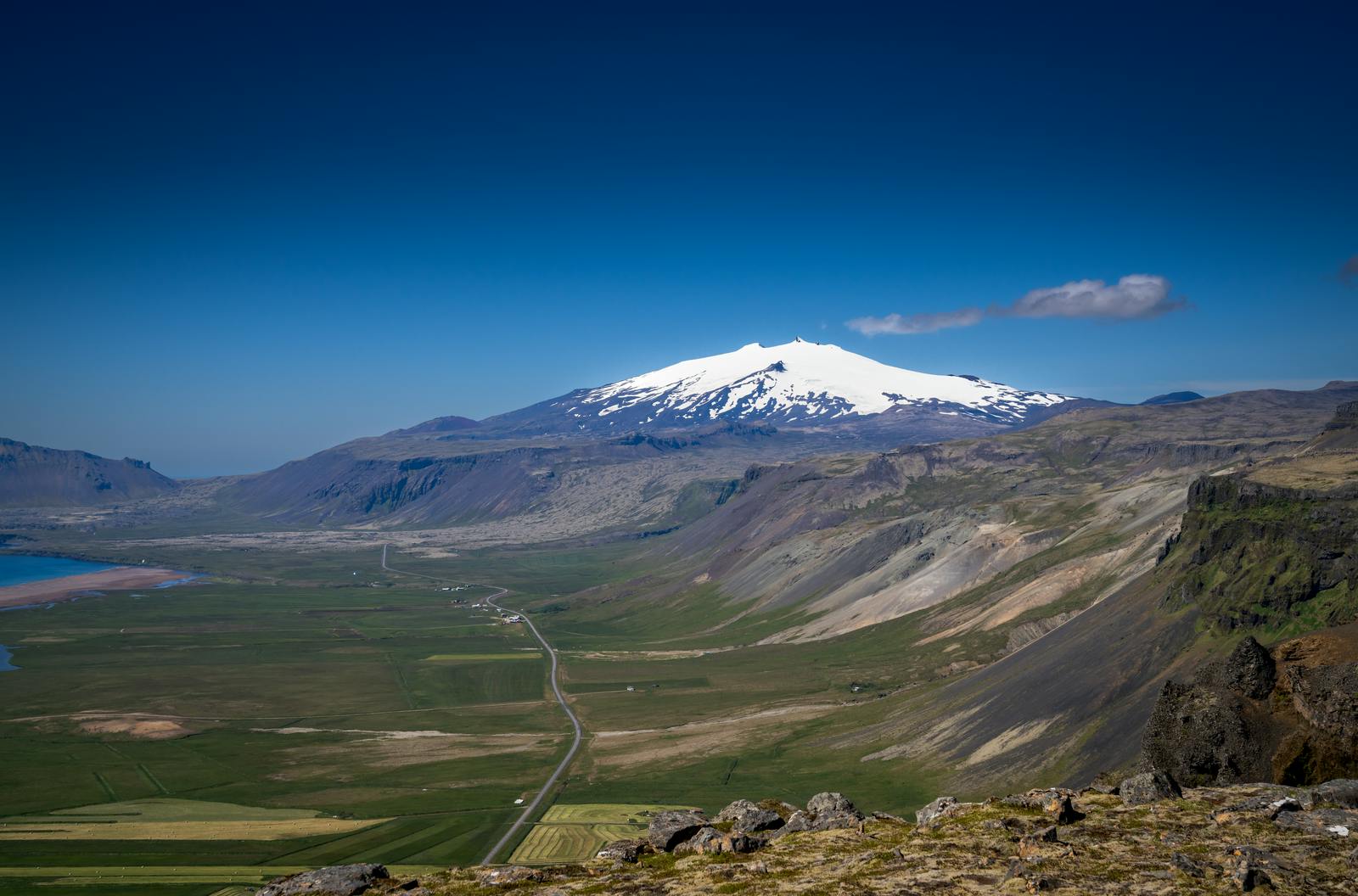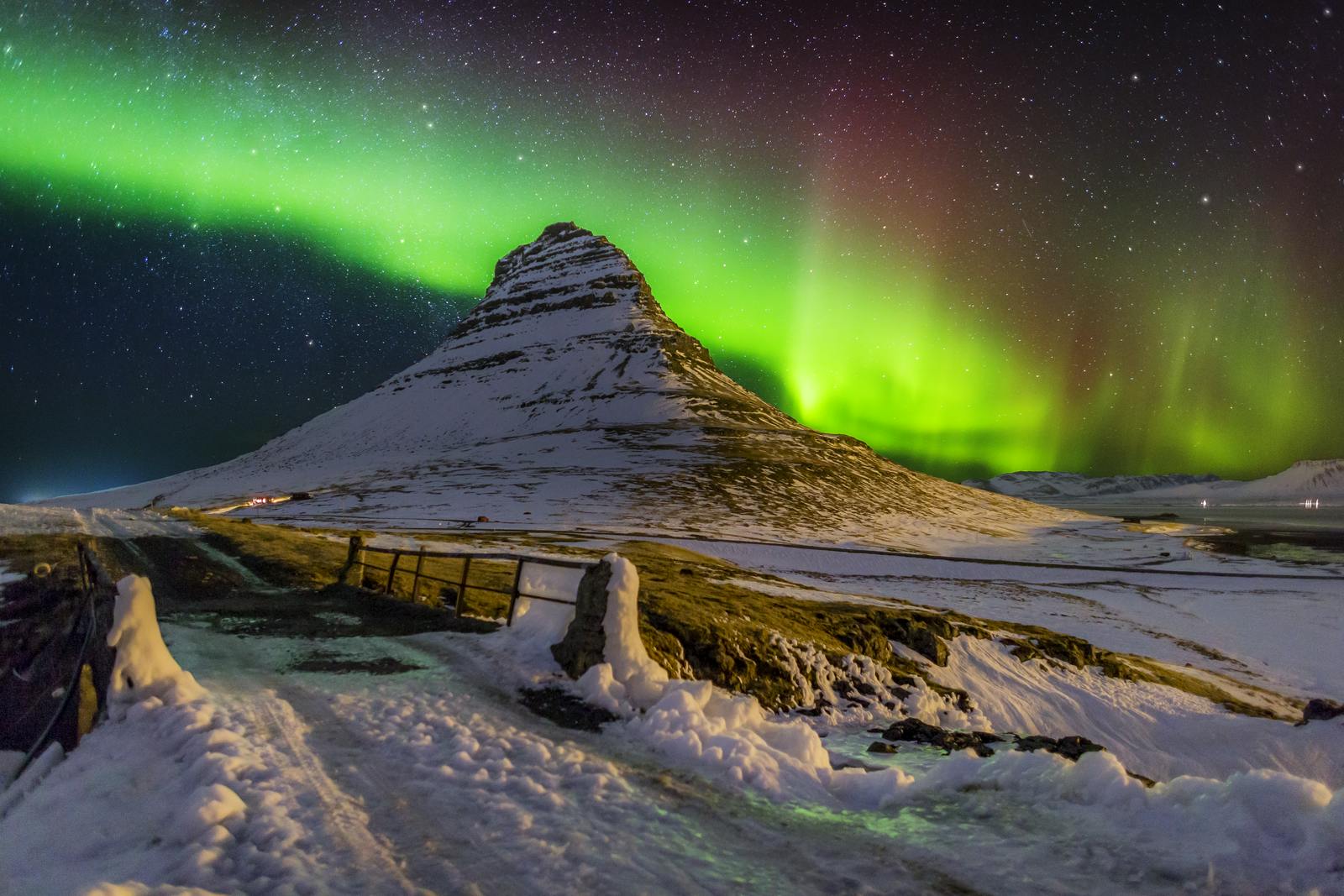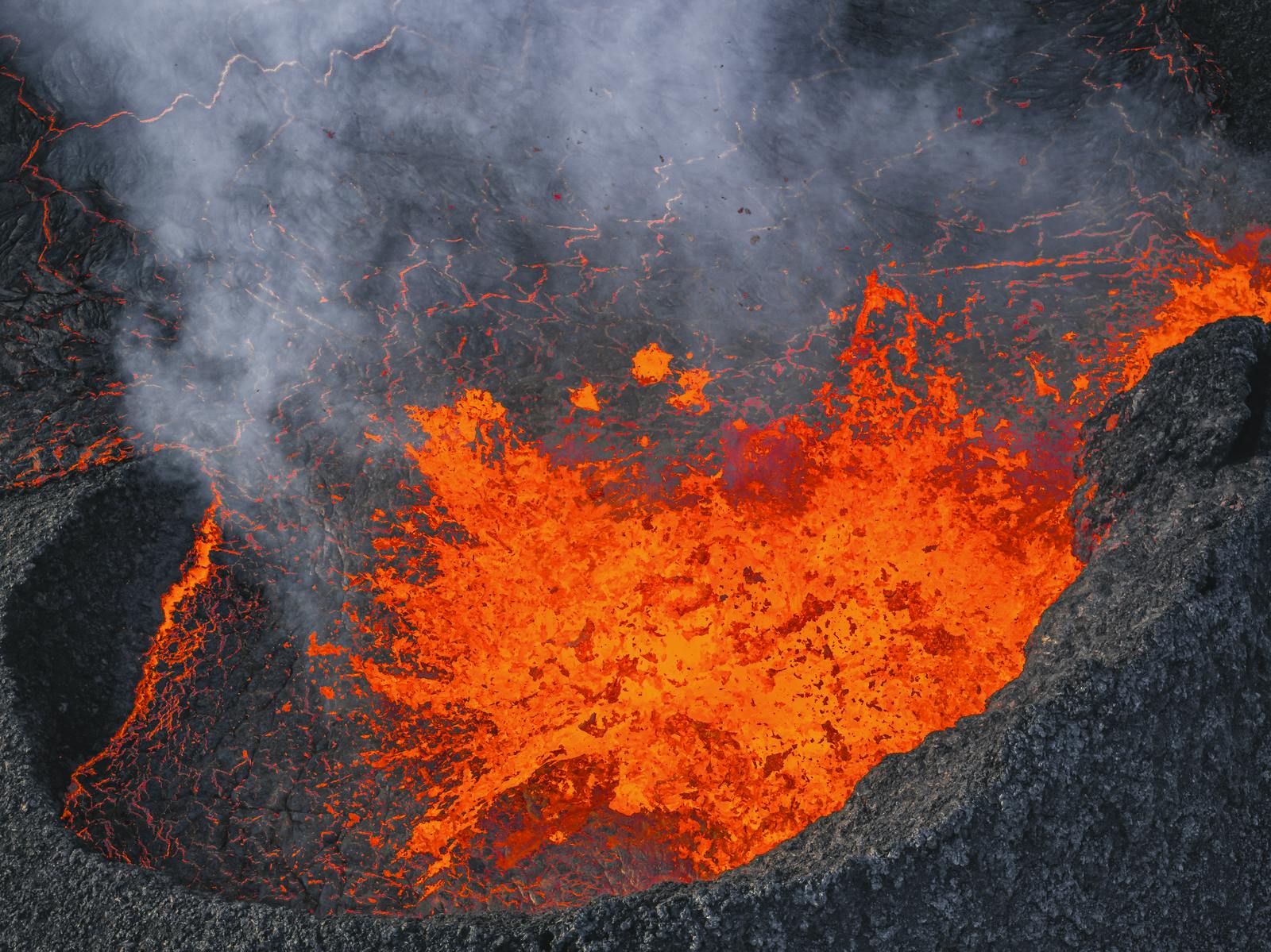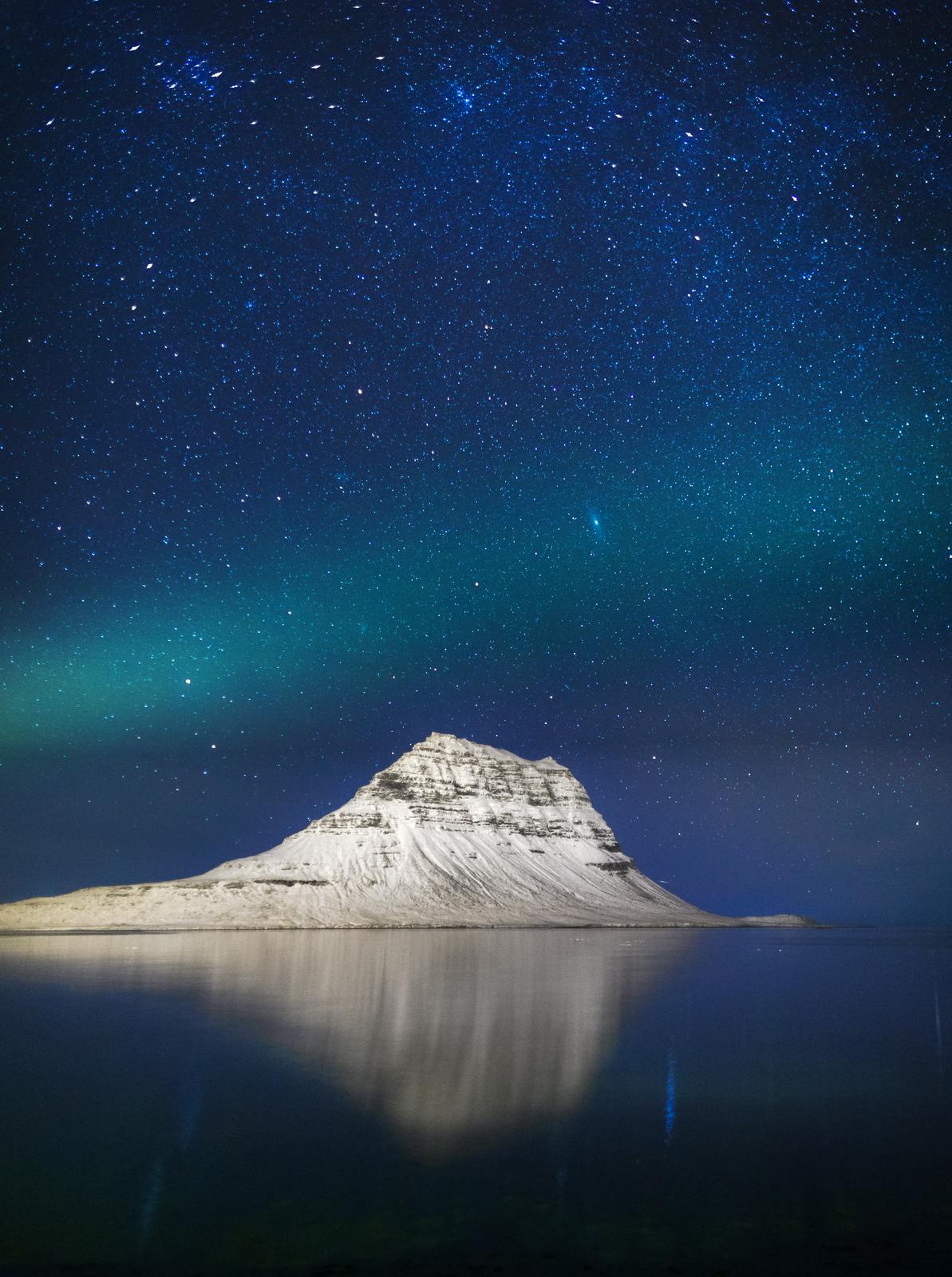
Snæfellsnes Peninsula
The Snæfellsnes Peninsula is a long, narrow finger of land extending from West Iceland into the North Atlantic Ocean. Although it’s only a two-hour drive from Reykjavik, it feels like a world away. Locals even call the region “Iceland in miniature”, as it packs the country’s most breathtaking natural wonders into one area.
Here, travellers can explore black sand beaches, dramatic basalt cliffs, moss-covered lava fields, and a glacier-capped volcano at its tip. Picturesque fishing villages dot the coastline, offering a front row seat to Iceland’s unique geological beauty.
Top Snæfellsnes Peninsula Attractions
The wealth of natural wonders can be overwhelming for anyone who wishes to visit Iceland for the first time. For a genuine experience of the region, here are the top attractions to explore on the Snæfellsnes Peninsula.
1. Mt. Kirkjufell

Travel to the peninsula’s north coast to catch a glimpse of the famous Kirkjufell Mountain. A photographer’s favourite, this 463-metre peak is also called “Church Mountain” for its distinct steeple-like shape. It’s striking through different seasons, from the ethereal glow of summer’s midnight sun to the dancing northern lights in winter. “Game of Thrones” fans may recognise Kirkjufell as Arrowhead Mountain from the show’s seventh season.
Right next to Mount Kirkjufell is the beautiful, three-tiered Kirkjufellsfoss waterfall. Together, the pair makes for one of the most iconic sights in the country. A walking trail winds around the mountain, while guided treks are available for experienced hikers eager to reach the summit.
2. Snæfellsjökull National Park

Wrapped around the glacier-capped Snæfellsjökull volcano is Snæfellsjökull National Park, the only national park in Iceland that kisses the ocean. Explore awe-inspiring landscapes, from seaside cliffs home to puffins to lava tube caves glittering with otherworldly hues.
Adventurers can climb the 1446 m high Snæfellsjökull, which famously inspired Jules Verne’s novel “Journey to the Center of the Earth.” As the story goes, the entrance to the Earth’s core is found in its caldera. Locals have long whispered tales about the Snæfellsjökull glacier blanketing the summit, telling stories of elves, trolls, and UFO sightings.
3. Djúpalónssandur Beach
The black sand and pebbled beach of Djúpalónssandur lies within Snæfellsjökull National Park. A favourite for sightseeing, this secluded cove is a dramatic landscape of dark shores hugged by rugged lava fields. The beach is scattered with the rusted fragments of a fishing trawler that was shipwrecked here in 1948.
Near the beach, travellers will also find four traditional lifting stones, remnants of a bygone era. These boulders were once used to test the strength of fishermen who lived in camps nearby and fished in the rich but dangerous fishing grounds off the coast.
4. Búðir Black Church

In the tiny hamlet of Búðir is a wooden black church known as Búðakirkja, first established in 1703. The local parish church’s stark black colour and simple design stand in quiet contrast to the vibrant Icelandic nature around it. Depending on the angle, Búðakirkja can be framed with a backdrop of the mountain range, lava fields, or Snæfellsjökull glacier.
5. Lóndrangar Rock Pinnacles
The twin Lóndrangar sea stacks loom over the Atlantic Ocean, a highlight of the Snæfellsnes Peninsula. Rising 75 and 61 meters high, the pinnacles have stood watch over the western shores for centuries.
Follow the trail to a viewpoint for a sweeping perspective of Lóndrangar and its surroundings. In summertime, keep an eye out for puffins and other seabirds that nest here, adding life to the rugged landscape.
6. Vatnshellir Cave
Within Snæfellsjökull National Park, the Vatnshellir Cave offers an unforgettable descent into an 8,000-year-old lava tube. A circular staircase leads into the underbelly of the cave, where rocky walls shimmer with a rainbow of mineral colours. At its deepest point (35 metres underground), visitors experience a profound, ancient darkness untouched for millennia. Vatnshellir Cave is only accessible via a guided hiking tour.
7. Gerðuberg Cliffs

Gerðuberg Cliffs feel mythical, like a giant lined up these colossal basalt columns and you’ve stumbled into their forgotten playground. Seven to 14 metres high, each column is a perfect hexagon, shaped by volcanic forces and slow cooling millennia ago. Travellers can walk up to the base of the cliffs to appreciate their sheer scale and geometric perfection up close.
8. Ytri Tunga Beach
In a country famed for black sand beaches, Ytri Tunga stands out as a rare gem with beautiful golden shores. This scenic beach is home to a colony of seals, specifically the harbour and grey species. The playful creatures can be seen year-round, either sunning on the rocks or swimming in the cool Atlantic waters.
Summer (June and July) is the best time to visit, as low tide exposes more rocks where seals enjoy sunbathing.
9. Berserkjahraun Lava Field
Explore Berserkjahraun, a vast and rugged lava field that almost looks like a scene from another planet. This otherworldly landscape formed 4,000 years ago when four scoria craters erupted, spewing a chaotic sea of hardened lava. Over the millennia, a blanket of green moss has softened the jagged edges of rocks, creating a stunning contrast.
Visitors can hike or drive through the lava field, where the winding road offers breathtaking vistas of nature.
10. Svörtuloft Lighthouse
From a lofty clifftop on the Snæfellsnes Peninsula, Svörtuloft Lighthouse is a beacon for ships and a striking sight. This vibrant, electric-orange lighthouse stands in shocking contrast to the sheer, black volcanic cliffs that plunge into the ocean below. A lesser-known detail adding to its charm is a hidden poem etched near the back of the 5.7-metre lighthouse.
11. Bjarnarfoss
Cascading 80 metres down basalt columns, the two-tiered Bjarnarfoss waterfall is an accessible stop on the Snæfellsnes Peninsula tour. A walking path from the parking lot leads visitors halfway up to the base of the falls. The water originates from a volcanic tuya mountain, tumbling over a rugged basalt cliff that adds to its dramatic beauty.
12. Eldborg
On the southern edge of the peninsula is the Eldborg crater that rises 60 metres above the surrounding lava fields. Its name translates to “Fortress of Fire,” a fitting tribute to its fortress-like appearance. This symmetrical spatter cone was formed during a volcanic eruption between 5,000 and 6,000 years ago.
The hike to the crater is a relatively easy 2.5-kilometre walk through a moss-covered lava field. Once at the base, you can climb a path to the rim to take in the panoramic vistas.

To learn more about historic volcanic eruptions in Iceland, consider visiting Perlan’s Volcano Show in Reykjavik.
Main Towns and Villages on Snæfellsnes Peninsula
The neighbouring hamlets of Arnarstapi & Hellnar on the peninsula's southern coast are connected by a scenic coastal path. Hellissandur & Rif, typical Icelandic fishing villages, are located on the lava-covered shore north of the Snæfellsjökull, near the westernmost tip of the peninsula.
On the northern side, Grundarfjörður & Ólafsvík are nestled in a fjord with views of the region's famous peaks. Grundarfjörður is considered the home of Mount Kirkjufell, while nearby Ólafsvík is a great spot for whale watching tours.
The largest town on the peninsula is Stykkishólmur on the northern shore. It’s known for its beautifully preserved old town with colourful, historic houses.
Snæfellsnes Peninsula in the Winter vs. Summer
The Snæfellsnes Peninsula is a spectacular destination in any season. During the summer, the peninsula's attractions are fully accessible, including the rugged, high-clearance F570 road that crosses the mountains just west of the glacier. This is the best time for hiking and enjoying the puffin colonies that nest on the cliffs.
In contrast, winter transforms the landscape with snow and ice. Though some roads may be closed, the main attractions remain open. Cliffs and mountains are capped with snow, creating stunning scenes under the ethereal glow of the Northern Lights.

How To Get to the Snæfellsnes Peninsula
Getting to the Snæfellsnes Peninsula from Reykjavik is straightforward, as it is only about a two-hour drive. A self-drive trip is popular, allowing travellers to explore at their own pace and linger at their favourite spots. The main ring road (Route 54) circles the peninsula and is well-maintained, making for an easy drive in most conditions.
FAQs
How long does it take to drive the Snæfellsnes Peninsula?
Driving the full peninsula loop (Route 54) takes about 3 to 4 hours without stops. At least a full day is recommended to explore the attractions on a Snæfellsnes Peninsula self-drive tour.
How do you pronounce Snæfellsnes?
Snæfellsnes is pronounced as "Sna-fel-snes" or "Snigh-fell-sness."
What to do in the Snæfellsnes Peninsula?
Explore a miniature version of Iceland's wonders, from black sand beaches and dramatic cliffs to lava fields and fishing villages.
Do you need a 4x4 for the Snæfellsnes Peninsula?
A 4x4 is not required for the main paved road (Route 54). However, it is necessary for unpaved F-roads, such as F570, which are only open in summer.
What is the largest town on the Snæfellsnes Peninsula?
The largest town on the peninsula is Stykkishólmur on the northern coast.
Can you do Snæfellsnes in one day?
Yes, it is possible to do a day trip from Reykjavík. However, spending at least one night in the area is highly recommended for a more relaxed experience.







